Sandra wakes up at a quarter to six to true Icelandic weather: it is really raining today, and the sky is grey and low. She writes the blog post for the previous day and then goes back to sleep… these all-day days are really discombobulating! At 7, it’s time to wake up to have breakfast and leave in time for Husavik, a one-hour drive. We have to be on time for our sailboat tour to see puffins and whales.
It’s still raining when we reach the harbour of Husavik. This small (pop. 3000) town seems to have just celebrated a festival of some sort, as each part of town has decorations of a different colour: pink, green, orange… We bundle up in our waterproof gear and head to the ticket office where we are told that we should be on the boat already: we thought we were expected at 9:30 for a 10 o’clock departure but apparently we were expected at 9 for the boat that is leaving NOW! Luckily they’re running a bit late so we manage to don a warm and dry sailor’s overall on top of all our clothes and run to the magnificent wooden schooner before it sets sail.
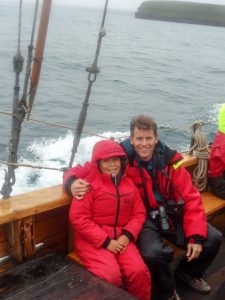
The four-hour cruise starts by heading to the small island of Lundey, home to 200’000 puffins. The grassy cliffs are dotted with the little creatures and surrounded by a cloud of birds. They are very cute with their white bellies and multicoloured beaks. Our Dutch guide explains that they are not very good fliers but mighty divers. They mate with a single partner and take turns to feed the babies. We spot a man walking on the island, and we are told this is the farmer who owns the land, so he has the right to hunt puffins but has to respect certain rules like only taking non-breeding males. Also we learn that all the land in the area used to be covered with forest that was completely wiped out a thousand years ago by the Vikings for building their houses and ships, and because the island is so young (and hence the topsoil so thin), the forest could not regenerate on its own. So in fact they had timber in medieval times here, and it is only recently they managed to grow forests again!
We leave the island and cross the large bay to head to a favourable spot for whale watching, where the river flows into the sea bringing lots of nutrients and other goodies for the cetaceans. During the crossing we sit at the prow and lulled by the pitch and roll the three of us fall into a snooze (like most of the other tourists… it has to be said that whale-watching is not the most adrenaline-pumping activity). Thankfully before we all slip into a permanent coma, a Minke whale comes to the rescue and shows a bit of fin to get us all excited. There is then a commotion because the boat suddenly rolls violently and a Dutch family who was standing at the prow falls on the deck with the mum crushing her sons’ head against the bowsprit in the process. Judging by his wailing that sure woke him up! To finish the tour we come across several humpback whales and are treated to several excellent and very close-up views of the leviathan. It’s great!
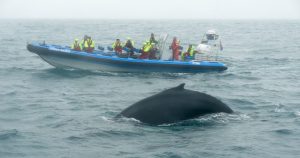
After a few other more distant humpback sightings we head back to the harbour. We chat with our guide, a young Dutch guy who has travelled around the world in tall sailing ships, so he is a seasoned sailor. He can’t use his skills today as there is no wind and we have to use the motor. He explains a bit about the different ships: the schooner differs from the ketch as it has the taller mast to the rear, the opposite to the ketch. Despite the cold and damp, we are still relatively comfortable thanks to our thick sailors’ overalls, and we all receive a cinnamon roll and a mug of hot chocolate with the “captain’s privilege” for those who want it: a good glug of Stroh, an Austrian liqueur. When we were skiing with the Jones in Austria we always used to order hot chocolate for the kids après-ski, and the mugs were always branded Stroh: funny that we had to go all the way to Iceland to discover that this is a brand of booze!
We return to land and head to the restaurant recommended by our guide, the Gamli Baukur. It’s right on the harbour, in a lovely wooden house. The inside is all wood with pretty maritime artifacts. We have an excellent lunch elegantly served: the kids menu for Ryo is roasted potatoes and chicken. Skye goes for a fish and seafood soup with home baked bread and Sandra for a delicious Arctic Char with pesto and a barley risotto. We also splurge on desserts: French chocolate cake with ice cream for Skye, and Sandra and Ryo share fantastic homemade blueberry ice cream with candied walnuts and pecans.
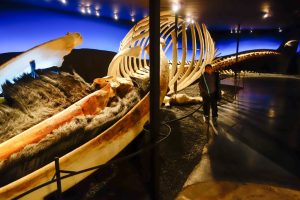
Before leaving town we visit the nice little whale museum and learn a lot about whales in Iceland. The pièce de résistance in the exhibition is the skeleton of a beached blue whale. Its size is mind-blowing. It’s also interesting to learn that these mammals migrate 10’000 km to warmer oceans to breed, but as there is no krill there, they stay without eating for 6 months, feeding their calves with rich fatty milk. In summer when they return north (or south in the southern hemisphere) they gorge themselves with food to replenish their stock of fat for the next breeding odyssey.
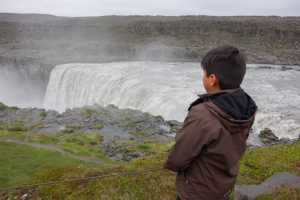
We drive on to our next destination, soon reaching the single lane dirt track down to the Dettifoss waterfall. We soon catch up to a few 2WD who have dared to risk it, but the car in front of us soon hits a mud patch and rips a big piece off the bottom of their vehicle and the occupants stop to contemplate it with a frown. The landscape is made of small cushions of peat vegetation. As we progress it becomes more and more eroded and lunar, until we finally reach Dettifoss itself. We have to walk to the waterfall through strange rock formations, like big piles of cube shaped stones. The falls themselves are impressive (the highest flow rate of any waterfall in Europe), but doesn’t daunt some crazy dudes on the opposite bank who are standing on the cliff right next to the raging torrent.
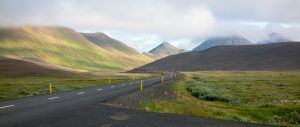
The last leg of our trip sees the sun finally poking through the clouds, casting warm light on a beautiful landscape. We reach Mödrudalur, a tiny settlement just a bit off the ring road. It’s impossibly quaint with its red-roofed church and turf huts. We check in at the Fjallakaffi and are given the keys of a hut big enough to sleep 10. We make ourselves comfortable after organizing our bags a bit.

There is no icebox in the freezer but the drinks did not get too hot in the car so we should be okay. For dinner we have some fish soup and vegetable rice. We tried to eat the fish jerky we bought (to try the local specialty) but they are way too tough. Cooking them in butter and white wine makes a palatable sauce but they still are too tough and now chewy, it’s still not very edible. I guess you have to be a starving Viking to appreciate it… oh well, at least we splurged on lunch!
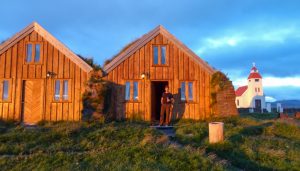
We finally get to bed close to midnight and have a solid night of sleep until 8 o’clock the next morning.
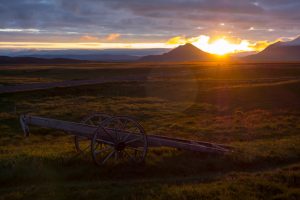
magnifique, j’aime bien vos tenues chaudes pour le bateau 🙂